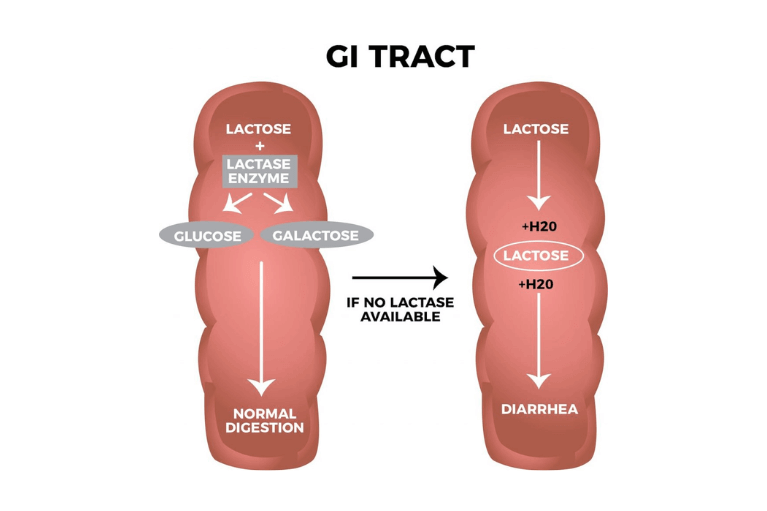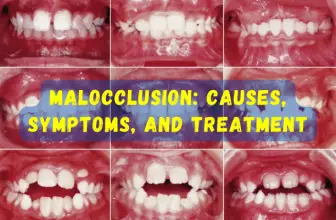Symptoms of Lactose Intolerance in Adults

Lactose intolerance is a common condition affecting up to 85% of adults over 50 (up to 90% of people with Asian ancestry). It’s estimated that 1 in every 25 people worldwide has some degree of lactose intolerance. The symptoms of lactose intolerance in adults are preventable, but first, it is crucial to learn the types and signs of lactose intolerance.
Lactose intolerance is the inability to digest lactose, a sugar found in milk and dairy products. Lactose sugar is usually broken down by an enzyme called lactase. However, most people have less of this enzyme after they are weaned, meaning they are unable to break down the sugar into glucose and galactose. The inability of the body to digest lactose leads to symptoms of lactose intolerance.
What Causes Lactose Intolerance?
The most common cause is lactase deficiency. There are many different types of lactase deficiency, each with different symptoms and causes. Types 1 and 2 are the most common. About 50% of adults have type 1 or type 2; most people develop it by age 20, but some develop it in childhood or adolescence. People with type 1 usually experience milder symptoms than those with type 2 because they may produce more than enough enzymes to digest foods containing large amounts of lactose (e.g., milk).
Another cause of sudden lactose intolerance is a condition called primary sclerosing cholangitis, where bile ducts become blocked or damaged. This causes the body to have an increased need for bile acids, which can be made from fats in your diet. When you eat dairy products, those fats are broken down into bile acids and absorbed through the intestinal wall into your bloodstream. If the bile ducts become blocked or damaged, then you’ll have trouble absorbing these compounds and digesting them without them being reabsorbed by your intestine.
Other causes of sudden lactose intolerance include celiac disease, Crohn’s disease (which also involves inflammation of the intestines), or an autoimmune disorder like rheumatoid arthritis.
Types of Lactose Intolerance
-
Primary Lactose Intolerance:
This is the most common type of lactose intolerance among adults. Primary lactose intolerance is when the body doesn’t produce enough of the enzyme lactase to break down lactose, a sugar found in milk.
This means that people who have primary lactose intolerance can’t digest lactose, which causes bloating and abdominal cramps after drinking milk or eating foods made with it. Some people may not be able to tolerate any level of lactose in their diet.
In most cases, the condition runs in families and may be genetic. However, it can also be caused by medications or medical conditions such as celiac disease or Crohn’s disease.
There are two types of primary lactose intolerance: congenital (present at birth) and acquired (present later in life). Congenital primary lactose intolerance is rare, affecting about 1% of babies, while acquired primary lactose intolerance affects about 5% of adults.
-
Secondary Lactose Intolerance:
This type is rare compared to primary lactose intolerance. Secondary lactose intolerance happens when there is an underlying gastrointestinal issue that decreases lactase production leading to lactose maldigestion.
Symptoms of Lactose Intolerance in Adults
The most common symptoms of lactose intolerance in adults are usually mild and can include the following:
-
Bloating (gas) and Abdominal Pain:
About 10% of adults have some degree of sensitivity to lactose, but many others can tolerate small amounts without any symptoms. The most common symptoms of lactose intolerance are gas and abdominal pain after eating dairy products.
-
Flatulence or Diarrhea:
It is another of the most common symptoms. However, this doesn’t mean that someone who has been diagnosed with lactose intolerance will always experience diarrhea when they eat dairy products. Only about 70% of people with severe lactose intolerance do. Furthermore, some people experience no symptoms at all and still produce excess levels of bacterial metabolites when they consume dairy products.
-
Nausea (upset stomach) and Aomiting:
If you have lactose intolerance, you may feel nauseous within 2 hours after eating or drinking dairy products. Symptoms of lactose intolerance in adults may vary based on a person’s age, but they typically include some combination of three or more of these signs and symptoms.
How Long do Lactose Intolerance Symptoms Last?
Generally speaking, symptoms will appear after eating foods containing lactose, such as milk, ice cream, or yogurt. The length of time the symptoms last depends on your body’s ability to break down lactose and absorb its nutrients. If you have a small amount of lactose in your system, it may take longer than if there is a large amount of lactose present.
Lactose Intolerance vs. Dairy Allergy
Lactose intolerance is a digestive issue that causes uncomfortable symptoms, such as bloating and gas when you eat dairy products. It’s common: about 65% of adults have trouble digesting lactose. But it’s not the same thing as an allergy to dairy—an allergy is an immune system response to a substance (in this case, milk).
Dairy allergies can vary in severity, but they all share some symptoms: skin rashes, swelling of the lips or tongue, gastrointestinal problems like diarrhea or vomiting, and more serious conditions such as anaphylaxis (a life-threatening reaction).
In contrast to these severe reactions, lactose intolerance is relatively mild. It can cause stomach discomfort, but it’s not life-threatening. You might not even notice that you don’t digest lactose well at all until you try eating dairy products for a few days in a row!
When it comes to lactose intolerance nearly all adults can experience the symptoms of lactose intolerance at some time or another. And while you might be tempted to blame the milk because it’s everywhere, it turns out there are causes for lactose intolerance besides consuming dairy. Just remember to avoid quick fixes and stick to a lactose-intolerant diet and a management plan. Your body will thank you later!
Resources:






